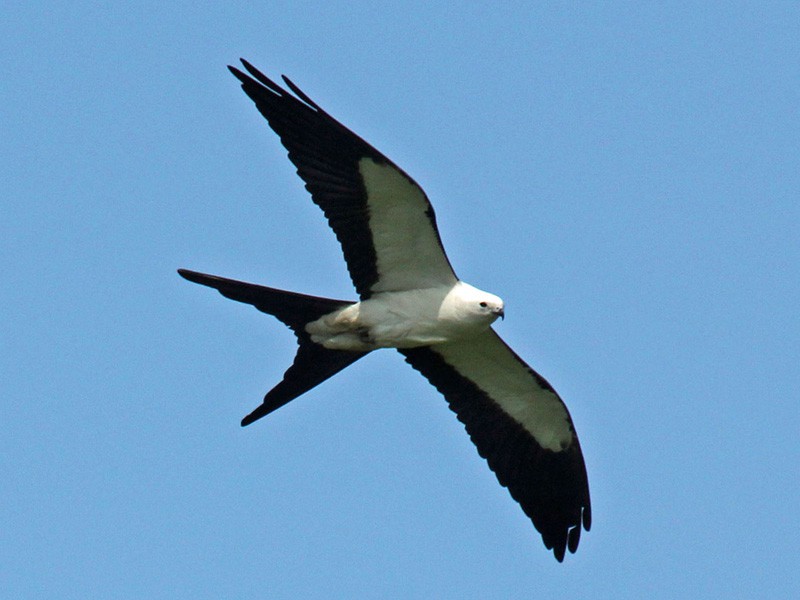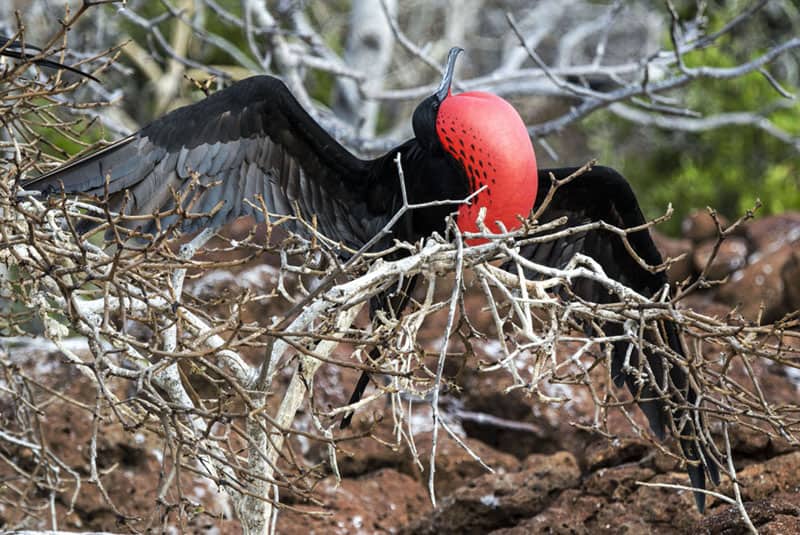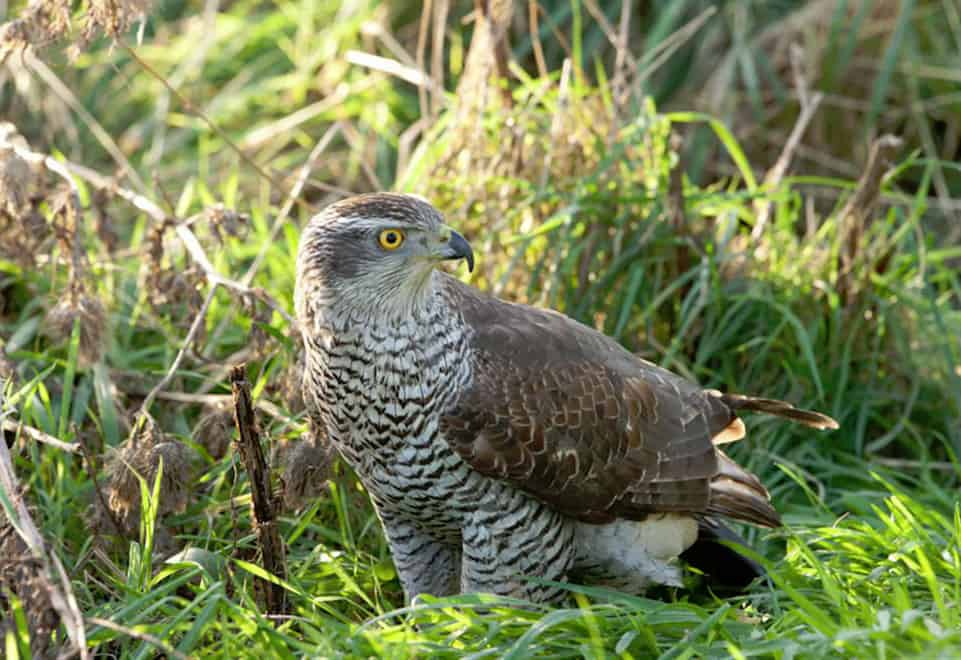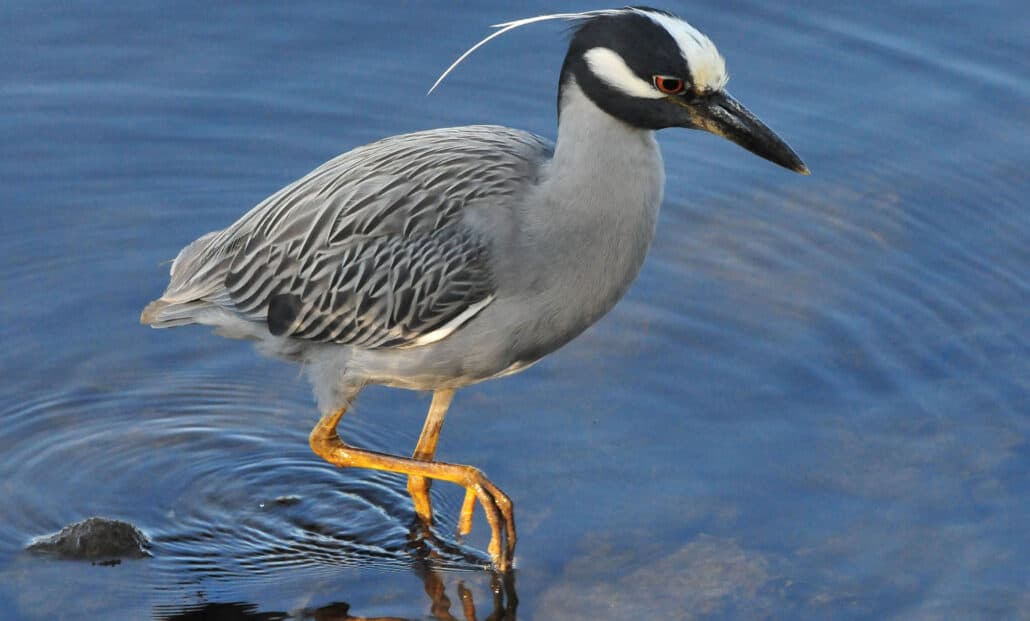
1. Common Loon
The well-known call of the common loon, a falsetto or yodeling wail, is the stuff of folklore. It awakens something primeval in our heart, but unfortunately is heard only occasionally in winter. Alabama is fortunate to have thousands of wintering loons. They arrive in mid-autumn and depart in early spring. Because these birds of Alabama are here during the winter, they generally are not wearing their spiffy breeding plumage, but instead have a winter coat of gray, with white throat and underparts. A large chunky upturned bill completes the ensemble.
They are quite common in the Tennessee Valley and near the coast, and less common but regular on all the lakes throughout Alabama. Besides the open waters of the gulf, the best place to see them in Alabama is on one of the lakes of the Tennessee River, from a boat landing or shoreline, using a scope. If you’re lucky, you may hear the call.
Common loons are unable to walk effectively on land, and must spend most of their lives, even sleeping, on the water. They feed individually during the day and gather in loose “rafts” at night, suggesting a social quality to their behavior. Look for a large gray bird on the water that spends more time under water than floating. It dives by raising its head, then following its bill forward in a swift, graceful dive that leaves hardly a ripple.

2. Swallow-tailed Kite
The swallow-tailed kite is strikingly beautiful. To see its incredibly graceful, sweeping flight is to witness absolute perfection. They are unmistakable. Large, with a wingspread of more than four feet, they have a white head with a very small beak. From above, everything else is black or charcoal gray. From below, the body is white, and the long, pointed wings are black except for the forward third nearest the breast, which is white. The defining feature is the deeply forked swallow-shaped black tail. Perched, they stand 24 inches high.
Swallow-tailed kites are trans-gulf migrants that begin returning to their Alabama breeding grounds in the Tensaw Delta and along the Tombigbee and Alabama Rivers in early March.
The best time to see these birds of Alabama is during migration, extending until mid-April. For the next two months, they are close to their nest sites, often in very remote areas, and only a fortunate few see them foraging for their young during May and June.
The swallow-tailed kite’s small bill and feet are not designed for ripping apart or crushing the life out of large prey. Rather, they eat dragonflies, catching them on the fly, and they pluck small lizards and such from treetops in flyby attacks.
Summer in south Alabama can be very hot and downright unbirdy. The sun and humidity can bake an unprotected birder in a few minutes, making birding unquestionable sticky. However, glancing up into the sky every once in a while can have its rewards. Among the best is to see a swallow-tailed kite gliding over, following an unknown path.
In addition to keeping one’s eyes turned skyward, there are a few places where the chances of seeing one of these special birds of Alabama are greater. Look for open fields where dragonflies might be flying, near a large river or swamp. Other, more specific places to look are on US 43, under the bridge across the Tombigbee River and the Choctaw National Wildlife Refuge in Choctaw County.
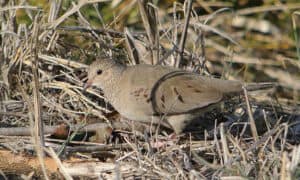
3. Common Ground-Dove
The common ground-dove is a small dove, only about 6 1/2 inches long, with short stubby wings that flash rufous in flight. As its name implies, it lives almost exclusively on or near the ground, often moving in small flocks. At close range, the bird has a scaly look about the head; otherwise it is tawny, tending to rufous in color.
They forage in cut fields, sandy woods, and near the beach. Because these birds of Alabama walk, not hop, on the ground they can be inconspicuous and hard to see, even when they are quite close. They are year-round residents, but are more often seen in the fall and winter, when grass and crops are not high.
The Fort Morgan peninsula, from Gulf Shores to the fort, is an excellent place to see ground-doves, as are the Fort Morgan grounds. They have nested recently on Dauphin Island, but a more recent hurricane has made their status their questionable. The cultivated fields and roads of Eufaula National Wildlife Refuge are excellent spots for these birds, particularly in fall and winter. The Dothan campus of Troy State University has an excellent nature trail where these and many other birds can be seen in fall and winter.
In spring, these birds can be identified by their call more often than by sight. Variously described as hoooip, hoooip or wooo-oo, wooo-oo, it is a rather hollow sounding coo that rises at the end and carries a great distance.

4. Red-cockaded Woodpecker
The red-cockaded woodpecker is one of the most famous birds of Alabama and North America, and one often confused with other woodpeckers by non-birders. The red cockade, one or two small feathers on the side of the male’s head, is almost never seen. They are large (about 8 1/2 inches long) black woodpeckers with white stripes running across the back, and with white underparts spotted with gray or black. The distinguishing feature is the white cheek patch and black crown. (Juveniles may have a tiny spot of red on their foreheads during summer.)
Red-cockadeds require mature pine forests, a habitat which is rapidly disappearing. They travel well away from the nest hole during the day and return only late in the evening. Therefore, except for nesting season, the most reliable way to see one is to locate an occupied nest hole and be there when the bird arises in the morning or when it returns in the evening.
Their nest holes are easy to identify because of the bird’s habit of drilling numerous small holes around the nest from which resin seeps and coats the tree, leaving a large signature of white resin readily visible. These resin patches are excellent snake deterrents because the pitch is irritating to snake bellies. During nesting season the birds enter and leave frequently as they feed their young, making them easy to see.
Their call, a loud, buzzy, nasal “tsick” is distinctive, and can lead you to them as they forage during the day.
There are several red-cockaded woodpecker locations in Alabama. The largest colony is in the Oakmulgee Division of the Talladega National Forest-West on Hale County Road 50 about 9 1/2 miles east of Moundville. Another reliable spot is the east end of Baldwin County Road 4 near Gulf Shores.
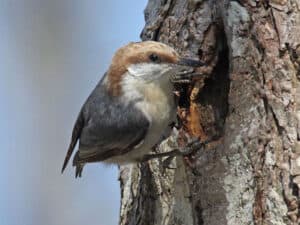
5. Brown-headed Nuthatch
Brown-headed nuthatches are delightful little birds of Alabama. They live almost exclusively in natural growth pines. They will frequent both seed and suet feeders, where they will take one seed or one bite and fly away to eat their morsel, returning many times, but almost never staying to sit and dine. Only 4 1/2 inches long, they have a gray back and wings, white throat and underparts, a brown cap extending from the eyes up, and a distinctive white spot at the nape of the neck.
The bill is long and needle-like. These birds of Alabama travel in small flocks and in the winter are often in the company of chickadees, titmice, downy woodpeckers, and both ruby-crowned and golden-crowned kinglets. They forage all around a pinecone or limb, creeping like a little mouse.
The brown-headed nuthatch’s call is squeaky like a mouse, KEY-he repeated often. In summer, look for them in piney woods. They are less common in the Tennessee Valley, but they are still present. In winter, look for small family flocks of nuthatches or look in larger mixed flocks in mixed woods.
They can be quite tame, and have often perched on my shoulder or head while I put out suet. They have also eaten suet from my hand.
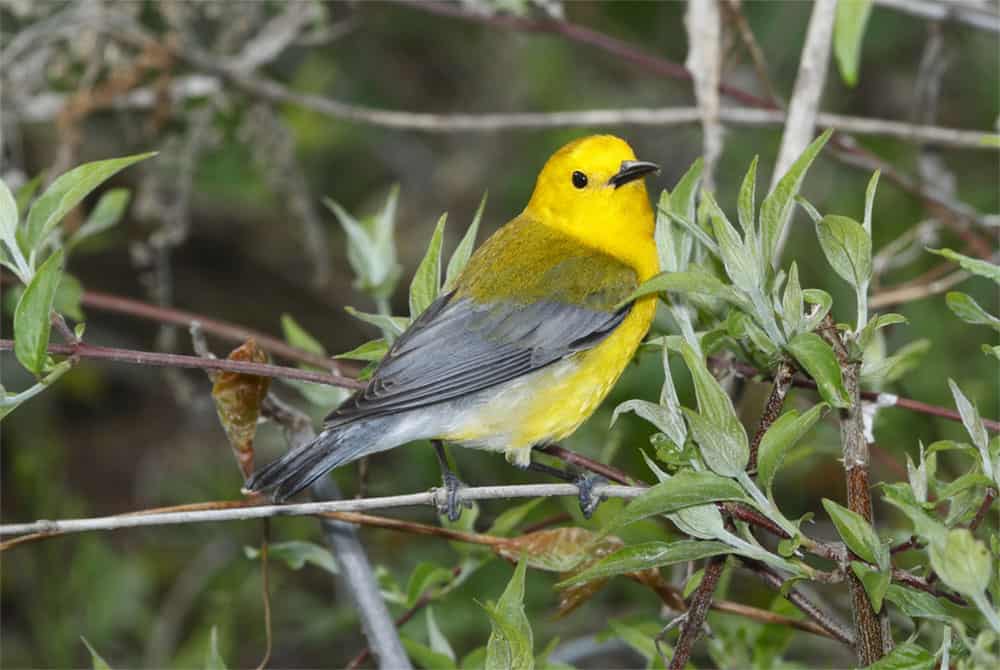
6. Prothonotary Warbler
The male prothonotary warbler is a breathtaking bird, with a head and body the color of the sun, and wings and short tail like molten silver. The undertail is white. The female is a duller but still beautiful version of the male. Prothonotaries breed in swampy lowland forests and riverbottom woodlands that are subject to flooding and build their nests in a cavity often over water. They may have two broods if conditions are favorable.
They arrive with spring, leave with summer, and breed in all regions of Alabama; however, they are more common below the fall line where there is more standing water and bottomland. The best place to see these birds of Alabama is where a bridge crosses over wooded swamps, or by walking the banks of streams in areas prone to flooding. There prothonotary warblers are a brilliant flash of color in an almost colorless world. They can often be located by their loud, clear, brassy song, tsweet tsweet tsweet tsweet tsweet, that can be heard some distance in swamps.
Prothonotary warblers remain low in trees and bushes, rarely getting above 25 feet. This makes them easier to see than many warblers. Additionally, they are relatively tame and very inquisitive, and can be approached very closely in a small boat such as a canoe.
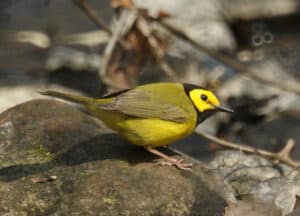
7. Hooded Warbler
Hooded warblers have a distinctive appearance. They have an olive green upper body, wings, and longish tail, and yellow underparts. The male’s head is black, with a bright yellow cheek patch surrounding a big black eye. The female is similar, except she has a yellowish throat, not black. When they forage, they constantly fan their tail, showing flashes of white.
The effect is quite striking and unmistakable. Hooded warblers live in moist, shady woodlands and ravines often near water, willow banks, and in dense undergrowth. They rarely forage higher than 15 feet. The male often forages on the ground and will perch on the side of a tree trunk to sing. They arrive in Alabama in early spring and leave in late summer.
Hooded warblers are often nearby residents of prothonotary warblers, living in the neighboring moist edges of the wet swamps. They are common in and around the Tensaw Delta and the river courses above it, but they can be seen almost any place in Alabama where moist woodlands or streambeds exist.
They build a neatly woven nest held together with spider webs, usually close to the ground. Also, they are more often located by their call than by sight. It is a loud multi-syllable song: weeta weeta tee tee-o.” It also has a loud chick note that carries well.

8. Blue Grosbeak
Blue grosbeaks blanket the state of Alabama during breeding season. They are smartly tailored in blue with cinnamon shoulder patches, a very prominent gray beak, and a long rounded tail. They are almost seven inches long. Blue grosbeaks are very eclectic about habitat, appearing to be happy with just about anything except urban and swampy areas.
However, woodland edges and grassy fields seem to suit them best. These colorful birds of Alabama are often seen in the company of indigo buntings, and can be confused with them until they are seen together. The differences then become very apparent. They often perch on utility wires, appearing black against the sky.
Blue grosbeaks arrive with spring and inland birds depart by the end of September. Birds along the coast leave a month later. They will frequent seed feeders, but they become less sociable after breeding starts. They have an unhurried, steady song of many notes, with a hoarse quality.
Although blue grosbeaks are common and can be seen virtually anywhere during the breeding season, possibly the most reliable place is the “bowl” of the Shell Mound on Dauphin Island throughout the month of April. If you don’t happen to be on Dauphin Island in April, look on any wire or fence post. You won’t have to wait long for this beauty.
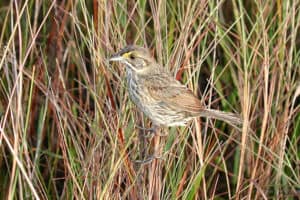
9. Seaside Sparrow
The seaside sparrow is a chunky olive-gray sparrow of saltwater marshes. Its general appearance at a distance is of a dark sparrow. The breast is light gray with faint streaks. The throat is whitish, the bill is large for a sparrow, and the tail is on the short side.
At close range, the distinguishing features are a yellow spot just above the bill, extending back almost to the eye, and brown primaries on the wings. The seaside sparrow has very large feet, enabling it to run on the gooey mud of the marsh. When it is flushed, it looks generally dark and chunky. Within its habitat, this, along with the short sparrow bill, is diagnostic.
This sparrow is a year-round resident of the salt marshes of coastal Alabama. The best place to see it is in south Mobile County, on the west side of Mobile Bay, especially at the Dauphin Island airport. It is rather secretive, but will respond to pishing.
Their call resembles a distant red-winged blackbird, but is a huskier, rather muffled “chup-til-zhreeee.”
The seaside sparrow has three subspecies, one of which, the dusky seaside sparrow, is already extinct. The Cape Sable seaside sparrow of southwest Florida is nearing extinction, both the victims of “development” of the beach, and other “improvements” such as mosquito control. The remaining subspecies holds its own, but its habitat is very restricted. And as our hunger for more beachfront grows, there may be fewer and fewer places to see these birds.
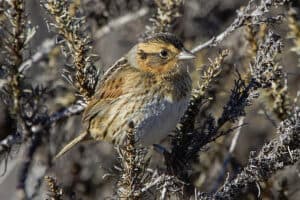
10. Nelson’s Sparrow
Nelson’s sparrow winters along Alabama’s coast. Observant birders, particularly in the saltwater marshes at the Dauphin Island airport, frequently see this species at the same locations as the seaside sparrow. It is a small, short-tailed sparrow, only about five inches long, with orangy head and breast, white belly, a gray nape or back of the neck, and rich brown patterned wings and back. They breed in the upper Midwest, mostly in Canada, so they are occasionally seen inland during migration.
Don’t be deterred by this LBJ (little brown job). Sparrows can be daunting to less experienced bird watchers, but by paying attention to habitat, and general impressions, most sparrows can be sorted out reliably. For instance, if you see, during fall and winter in Alabama, a small light-colored sparrow in a saltwater marsh, and its head and breast appear orangy, you have a Nelson’s sparrow.
They are inquisitive birds that will respond to pishing or mechanical bird squeakers. When approached too closely, they do not fly; instead they run mouse-like through the grass, with their head down.
Nelson’s sparrow was formerly called Nelson’s sharp-tailed sparrow, and before that, it and the saltmarsh sparrow were considered one species, the sharp-tailed sparrow.
How Many of These Birds of Alabama Have You Seen?

